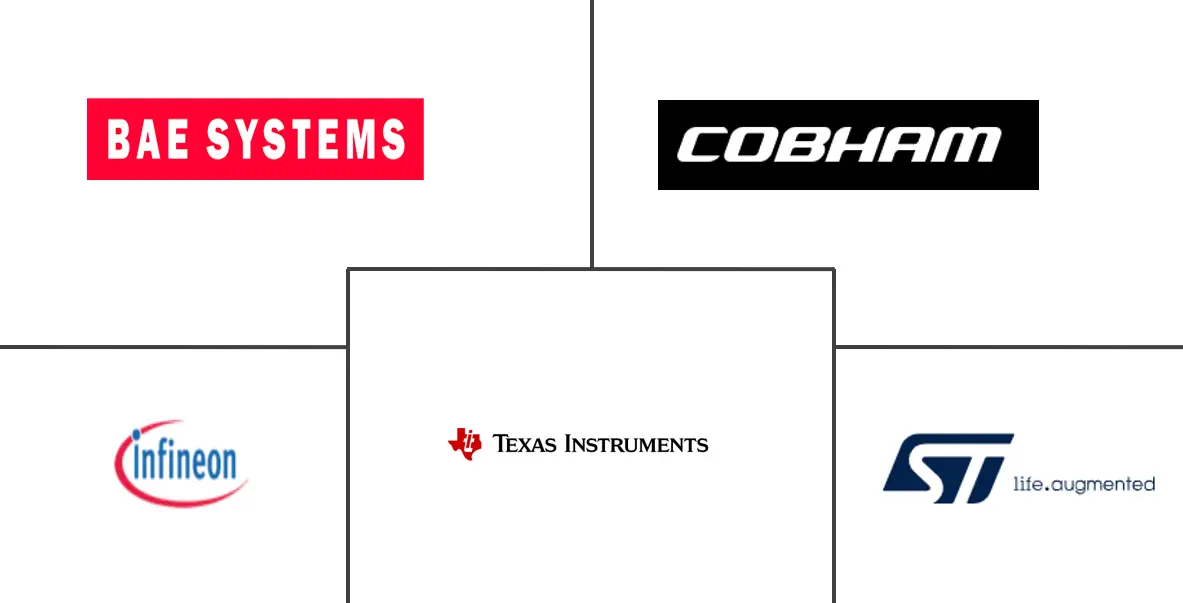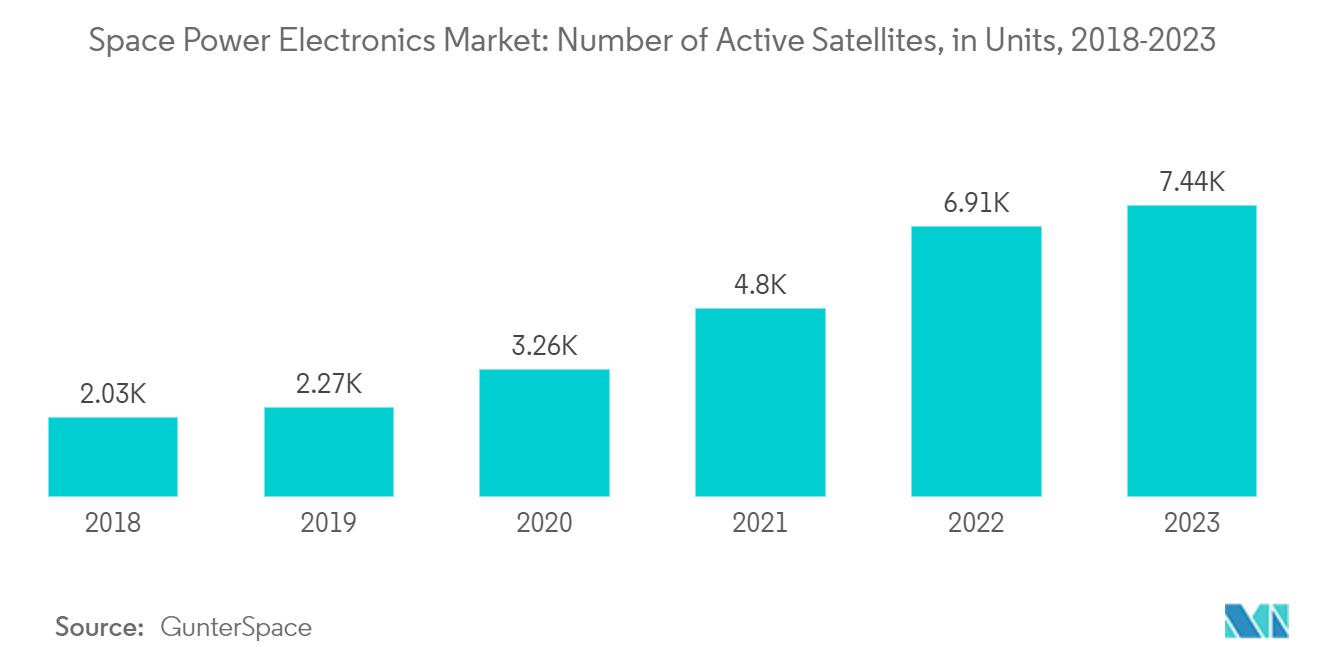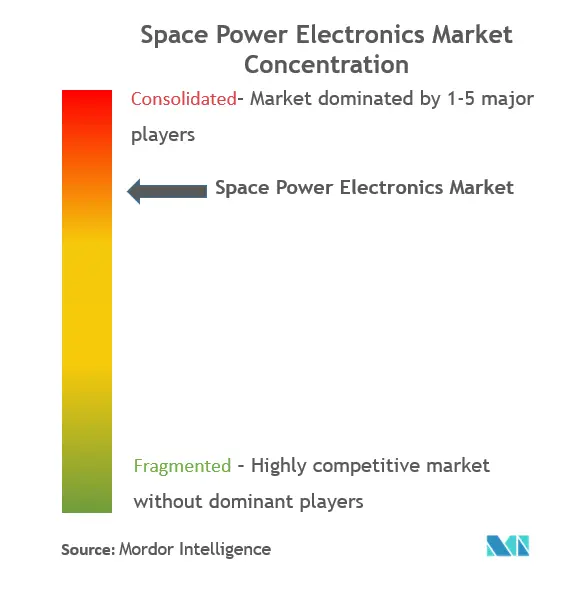Space Power Electronics Market Size

| Study Period | 2019 - 2029 |
| Market Size (2024) | USD 320.35 Million |
| Market Size (2029) | USD 635.21 Million |
| CAGR (2024 - 2029) | 14.68 % |
| Fastest Growing Market | Asia Pacific |
| Largest Market | North America |
Major Players
*Disclaimer: Major Players sorted in no particular order |
Space Power Electronics Market Analysis
The Space Power Electronics Market size is estimated at USD 320.35 million in 2024, and is expected to reach USD 635.21 million by 2029, growing at a CAGR of 14.68% during the forecast period (2024-2029).
The development of power electronics for space applications has been driven by advancements in semiconductor technologies and the need for efficient power management systems. Wide bandgap semiconductors, for instance, have emerged as a significant innovation, offering improved performance over traditional materials. Power electronics systems in space also include modular power electronic subsystems (PESS) that connect to a source and load at their input and output power ports. These systems are integral to operating satellites, spacecraft, launch vehicles, and rovers, ensuring they have the necessary power to perform their functions.
The space power electronics market is experiencing growth due to the increasing development of low-Earth orbit (LEO) satellites and reusable launch vehicles. These advancements drive the demand for more sophisticated power management devices, batteries, and power converters, which are essential for the long-term sustainability and efficiency of space missions.
However, the market faces significant challenges, such as the high costs associated with designing and developing these complex systems and the rigorous integration and quality inspection process required for space applications. Despite these challenges, the industry's commitment to research and development is expected to overcome these restraining factors, leading to considerable growth over the forecast period.
Space Power Electronics Market Trends
Satellites are Expected to Dominate the Market During the Forecast Period
The satellite segment is expected to dominate the market during the forecast period owing to the increasing demand for satellites for various applications such as communication, navigation, earth observation, and others. A surge in the small satellite sector was witnessed in the last decade, fueled by significant technological advancements, the commercialization of the industry, and an influx of private capital. This momentum was propelled by increased interest in space exploration and the need for small satellites to perform complex tasks such as attitude and orbit control, orbital transfers, and responsible end-of-life deorbiting strategies.
The miniaturization of power electronics has been particularly beneficial for CubeSats, enhancing their performance and reliability. Concurrently, the burgeoning NewSpace industry is embracing modularization, with components like miniaturized radiation-hardened MOSFETs, gate drivers, DC-DC converters, and solid-state relays becoming standard, reflecting a trend toward more efficient, scalable, and cost-effective satellite designs.
For instance, in January 2023, Airbus signed a contract with the Belgian Ministry of Defense to provide tactical satellite communications services to the armed forces for 15 years. Airbus plans to launch a new ultra-high frequency (UHF) communications service by 2024 for the armed forces of other European nations and NATO allies. Developments such as these are driving the growth of the market.

Asia-Pacific is Expected to Register the Highest CAGR During the Forecast Period
The Asia-Pacific region is witnessing a significant evolution in the space industry, particularly in space power electronics. Key trends include the increasing recognition of space as a vital part of national security, the rise of small private commercial space startups, and a shift in focus toward exploiting space resources. Countries like China, India, and Japan are leading the way with ambitious space programs to establish their presence in space by developing technologies for lunar exploration and asteroid mining.
The satellite communication equipment market in the region is experiencing growth due to the rising demand for high-speed internet connectivity. This growth is supported by major satellite operators such as Singtel and Thaicom, which contribute to the more than 100 million active pay satellite TV subscribers in Asia. For instance, in December 2023, China announced that it would be building its version of StarLink, a satellite internet constellation using low-Earth orbit, with plans to launch around 26,000 satellites to cover the entire world, led by state-run companies.
Thus, the advancements in space power electronics are crucial for these developments, as they enable the creation of more efficient and reliable systems for power management in satellites, which is essential for long-term missions and deep space exploration.

Space Power Electronics Industry Overview
The space power electronics market is consolidated, with key players occupying a significant market share. The major players in this market are BAE Systems PLC, Cobham Limited, Infineon Technologies AG, Texas Instruments Incorporated, and STMicroelectronics NV. These companies are at the forefront of developing powerful electronic devices that can withstand harsh conditions in space, such as extreme temperatures and radiation.
The leading market players are focusing more on acquiring contracts to maintain their market position. This approach is often complemented by introducing innovative products featuring cutting-edge technologies. For instance, in April 2023, ZF signed a multi-year supply agreement with STMicroelectronics for silicon carbide devices. Collaborations have become instrumental in establishing specialized research and development centers dedicated to advancing space power electronics equipment, signifying a robust commitment to innovation and growth in this high-tech field.
Space Power Electronics Market Leaders
-
Cobham Limited
-
Texas Instruments Incorporated
-
BAE Systems plc
-
Infineon Technologies AG
-
STMicroelectronics N.V.
*Disclaimer: Major Players sorted in no particular order

Space Power Electronics Market News
October 2023: Infineon Technologies AG acquired Gallium Nitride Systems for USD 830 million.
June 2023: The UK Space Agency, in partnership with ADS Group, awarded Icemos Technology part of USD 345 thousand in prestigious funding for advancements in radiation-tolerant power electronics.
Space Power Electronics Market Report - Table of Contents
1. INTRODUCTION
- 1.1 Study Assumptions
- 1.2 Scope of the Study
2. RESEARCH METHODOLOGY
3. EXECUTIVE SUMMARY
4. MARKET DYNAMICS
- 4.1 Market Overview
- 4.2 Market Drivers
- 4.3 Market Restraints
-
4.4 Porter's Five Forces Analysis
- 4.4.1 Bargaining Power of Buyers/Consumers
- 4.4.2 Bargaining Power of Suppliers
- 4.4.3 Threat of New Entrants
- 4.4.4 Threat of Substitute Products
- 4.4.5 Intensity of Competitive Rivalry
5. MARKET SEGMENTATION
-
5.1 Platform
- 5.1.1 Satellites
- 5.1.2 Spacecraft and Launch Vehicles
- 5.1.3 Others
-
5.2 Type
- 5.2.1 Radiation-Hardened
- 5.2.2 Radiation-Tolerant
-
5.3 Application
- 5.3.1 Communication
- 5.3.2 Earth Observation
- 5.3.3 Navigation, Global Positioning System (GPS) and Surveillance
- 5.3.4 Technology Development and Education
- 5.3.5 Others
-
5.4 Geography
- 5.4.1 North America
- 5.4.1.1 United States
- 5.4.1.2 Canada
- 5.4.2 Europe
- 5.4.2.1 United Kingdom
- 5.4.2.2 France
- 5.4.2.3 Germany
- 5.4.2.4 Russia
- 5.4.2.5 Rest of Europe
- 5.4.3 Asia-Pacific
- 5.4.3.1 China
- 5.4.3.2 India
- 5.4.3.3 Japan
- 5.4.3.4 South Korea
- 5.4.3.5 Rest of Asia-Pacific
- 5.4.4 Latin America
- 5.4.4.1 Brazil
- 5.4.4.2 Rest of Latin America
- 5.4.5 Middle East and Africa
- 5.4.5.1 Saudi Arabia
- 5.4.5.2 United Arab Emirates
- 5.4.5.3 Rest of Middle East and Africa
6. COMPETITIVE LANDSCAPE
- 6.1 Vendor Market Share
-
6.2 Company Profiles
- 6.2.1 BAE Systems PLC
- 6.2.2 Cobham Limited
- 6.2.3 Microchip Technology Inc.
- 6.2.4 RUAG Group
- 6.2.5 STMicroelectronics NV
- 6.2.6 Teledyne Technologies Incorporated
- 6.2.7 Texas Instruments Incorporated
- 6.2.8 Honeywell International Inc.
- 6.2.9 Microsemi Conduction
- 6.2.10 ON Semiconductor
- 6.2.11 Analog Devices Inc.
- 6.2.12 Renesas Electronics Corporation
- 6.2.13 Infineon Technologies AG
- *List Not Exhaustive
Space Power Electronics Industry Segmentation
Space power electronics are key components in controlling and converting electrical power within spacecraft. These systems are designed to handle the unique challenges of space, such as extreme temperature fluctuations and radiation levels, which can affect the performance and reliability of electronic devices.
The space power electronics market is segmented based on type, platform, application, and geography. Based on type, the market is segmented into radiation-hardened and radiation-tolerant. The market is segmented into satellites, spacecraft and launch vehicles, and others by platform. Based on application, the market is further segmented into communication, earth observation, navigation, global positioning system (GPS) and surveillance, technology development and education, and others. The report also covers the market sizes and forecasts for across major regions. For each segment, the market sizing and forecasts were made on the basis of value (USD).
| Platform | Satellites | |
| Spacecraft and Launch Vehicles | ||
| Others | ||
| Type | Radiation-Hardened | |
| Radiation-Tolerant | ||
| Application | Communication | |
| Earth Observation | ||
| Navigation, Global Positioning System (GPS) and Surveillance | ||
| Technology Development and Education | ||
| Others | ||
| Geography | North America | United States |
| Canada | ||
| Geography | Europe | United Kingdom |
| France | ||
| Germany | ||
| Russia | ||
| Rest of Europe | ||
| Geography | Asia-Pacific | China |
| India | ||
| Japan | ||
| South Korea | ||
| Rest of Asia-Pacific | ||
| Geography | Latin America | Brazil |
| Rest of Latin America | ||
| Geography | Middle East and Africa | Saudi Arabia |
| United Arab Emirates | ||
| Rest of Middle East and Africa |
Space Power Electronics Market Research FAQs
How big is the Space Power Electronics Market?
The Space Power Electronics Market size is expected to reach USD 320.35 million in 2024 and grow at a CAGR of 14.68% to reach USD 635.21 million by 2029.
What is the current Space Power Electronics Market size?
In 2024, the Space Power Electronics Market size is expected to reach USD 320.35 million.
Who are the key players in Space Power Electronics Market?
Cobham Limited, Texas Instruments Incorporated, BAE Systems plc, Infineon Technologies AG and STMicroelectronics N.V. are the major companies operating in the Space Power Electronics Market.
Which is the fastest growing region in Space Power Electronics Market?
Asia Pacific is estimated to grow at the highest CAGR over the forecast period (2024-2029).
Which region has the biggest share in Space Power Electronics Market?
In 2024, the North America accounts for the largest market share in Space Power Electronics Market.
What years does this Space Power Electronics Market cover, and what was the market size in 2023?
In 2023, the Space Power Electronics Market size was estimated at USD 273.32 million. The report covers the Space Power Electronics Market historical market size for years: 2019, 2020, 2021, 2022 and 2023. The report also forecasts the Space Power Electronics Market size for years: 2024, 2025, 2026, 2027, 2028 and 2029.
Space Power Electronics Industry Report
Statistics for the 2024 Space Power Electronics market share, size and revenue growth rate, created by Mordor Intelligence™ Industry Reports. Space Power Electronics analysis includes a market forecast outlook for 2024 to 2029 and historical overview. Get a sample of this industry analysis as a free report PDF download.



